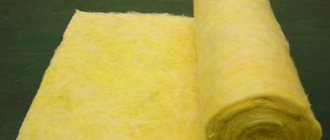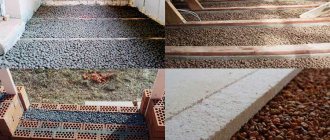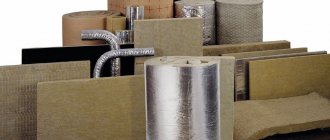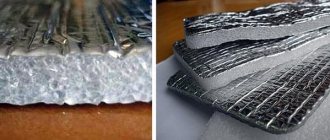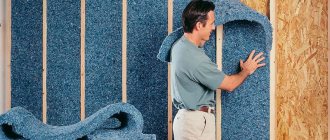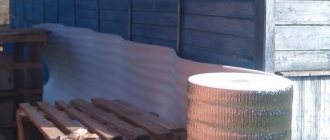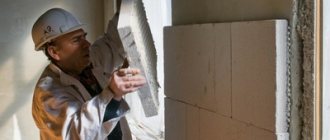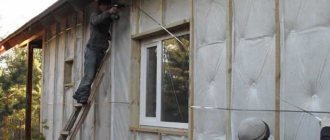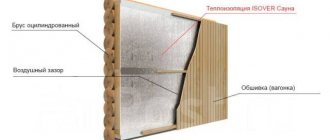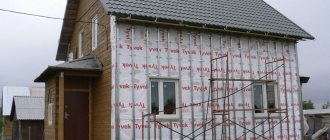Despite the emergence of new, more convenient to use thermal insulation materials, glass wool is still considered one of the most common insulation materials. In its origin and structure, it is a type of mineral wool. Glass wool is an insulation material obtained from waste from the glass industry, is inexpensive and is widely used in construction.
One of the most popular thermal insulation materials
Glass wool production
Glass wool production occurs in several stages.
- At the first stage, 80% glass and 20% lime, sand, soda and ethibor are loaded.
- All this is connected and placed in the heating compartment.
- The composition is heated in an oven to a temperature of 1400 degrees.
- To achieve fine threads, the composition is strictly controlled
Subsequently, the composition is stretched along a conveyor and treated with polymer aerosols, which help to stretch the threads and join them into a carpet.
After this, the temperature in the chamber rises to 250 degrees, at which point the fibers begin to harden and the remaining aerosol evaporates. After these steps, the cotton wool is left to cool.
Characteristics of glass wool
Glass wool has a number of inherent qualities
- The thickness of the glass wool layer can be from 3 to 15 cm.
- The length of one glass fiber can be from 10cm to 30cm.
- Due to the length of the fibers, the strength and elasticity of the material is improved.
- Vibration resistant.
- The thermal conductivity of glass wool ranges from 0.030 to 0.052 W.
- Able to withstand heating up to 450 degrees.
Fiberglass is used on a wide variety of objects for the purpose of thermal insulation. This could be a residential building, a heating main, industrial tanks and buildings that need to be protected from fire.
The type of building, or rather the location of the surface in space, does not play a special role. Glass wool can be insulated as horizontal, vertical or even surfaces located at different angles.
Types of glass wool products
- Soft mats;
- Soft, semi-soft and hard sheets with non-natural connecting components. Semi-soft and hard sheets withstand heavy loads well;
- Sheets with increased rigidity and glass felt lining also protect against gusts of wind.
Fastening long glass wool slabs can be done in two ways: tongue and groove. It is these two methods of fixation that perfectly fix the sheet without any gaps and are considered very effective.
Fastening a tongue and groove is a connection of two parts of a sheet, or rather, fixing a protrusion into a groove of the second sheet. Toe fastening is the joining of two sheets of glass wool using the tongue and groove technique.
- In production, finished fiberglass is rolled into a roll for ease of use and transportation. This does not affect the quality of the fiber in any way.
- After unpacking, the fiber quickly straightens and takes on the desired volume.
- For greater ease of use and preservation of the material's value, glass wool is additionally reinforced with a layer of cashmere.
- It also does not allow steam to penetrate through the fibers. This layer looks like foil.
There are a number of companies that produce fiberglass with an additional layer of cashmere: Ursa, Knauf, Isover, Neman.
Areas of application
If we talk about industries of application, then these are:
- construction;
- heat supply;
- production;
- automotive industry;
- aviation;
- pipeline transportation of materials.
For each sphere, different types are selected , differing:
- fiber type,
- their location,
- the presence of additional coatings,
- density (maximum possible - 130 kg/m3).
The most common types of glass wool are rolls and soft mats.
Fiberglass insulation is available in the form of:
- continuous thread (rolls);
- staple (cut) fiber (slabs), including those characterized by increased rigidity with lining;
- soft mats;
- reinforced rolls;
- cached technical insulation, including in the form of foil products.
Rolls have long been successfully used for insulating horizontal surfaces - floors, roofs.
Cached type - for insulating high-temperature pipelines, components and containers.
Mats and slabs are used for thermal insulation of various rooms and structural elements, namely:
Read also: How to draw a watermelon on your nails?
- facades;
- window and door openings;
- interfloor and other floors;
- internal and external partitions of buildings;
- sound and thermal insulation of cabins.
The cotton wool should be secured in such a way as to ensure a free position (for maximum expansion) and at the same time a tight fit without gaps.
Health effects of fiberglass
In 1997, studies were conducted in Europe on the effects of mineral wool on human health. The criteria by which they examined mineral wool were: fiber size, the presence of oxides and alkali metals in the composition.
Mineral wool should have been classified into the second or third hazard class. The second class of hazard involves the presence of irritating substances and the presence of dangerous irritants. The third class of hazard means that the availability of data on the composition does not allow a thorough verification of the harmfulness of the product.
Only in 2001, the result of a study of mineral wool on the analysis of carcinogenic substances was presented to the public. It was classified in the third class, that is, not causing diseases in the human body.
Differences from mineral wool
Due to their somewhat similar appearance and comparable properties, many are interested in the question: glass wool and mineral wool - what is the difference?
- In raw materials. Mineral wool consists of fibers that are made from molten rocks or silicates. The raw material for glass wool is broken glass.
- In fiber size. On average, the thickness of the fibers of mineral insulation is less, as is the length. Hence, there are some differences in insulating properties in favor of glass wool. On the other hand, material based on glass fibers is more susceptible to shrinkage and deformation.
- In cost. Mineral material is more expensive.
- In the specifics of the work. Glass wool is more difficult to work with, also because its fibers are somewhat dangerous.
Precautionary measures
When working with glass fiber you need to be very careful. You need to wear overalls made of fairly dense material. Prevent small pieces of fiberglass from coming into contact with your skin. No exposed skin is allowed. The eyes and respiratory tract also need to be protected. Wear goggles and a respirator.
During operation, the fiberglass breaks and small, sharp glass particles are formed; when they come into contact with the skin, they cause itching. Getting them into the respiratory tract is extremely dangerous. Once fiberglass debris gets on your clothing, it will be nearly impossible to remove.
If contact with glass wool particles does occur, you must do the following:
- Do not scratch areas of the skin that have come into contact with the fiberglass.
- If particles of fiber get on your hair, carefully shake them off and close your eyes. After which the head is lowered into the bathtub or a deep cup, shaking the neck to shake off the residue from the hair.
- Then take the spirit under a strong stream of cold water. Hot perfume is categorically excluded, as it expands the pores.
- If fibers get into your eyes, they should also be rinsed with water. Then contact an ophthalmologist.
- If fragments of fiberglass get into the respiratory tract and cause difficulty breathing, you should immediately go to the hospital.
It is better to throw away the clothes you worked in. Even washing several times will not help remove fiberglass from clothing.
Disadvantages of the material
- High degree of moisture absorption. When using this material in exterior decoration, or in rooms characterized by a high degree of humidity, it is necessary to use waterproofing and vapor barrier materials. Otherwise, cotton wool saturated with water deteriorates its thermal insulation properties by 40 percent, while increasing fragility;
- Cotton wool is based on tiny glass fibers. And although they are safe from an environmental point of view, they are also very destructive to health. Working with glass wool without proper protection can cause the emergence and exacerbation of many indolent diseases. Therefore, it is recommended to work with the material in a respirator and protective suit, but in the room the windows should be open and full air movement should be ensured;
Important! The previous point has now become less relevant, since in modern models of the material this danger has been reduced. But eye and skin protection and a respirator, as well as good room ventilation, are still advisable.
- The fragility of the fibers leads to the fact that over time such wool shrinks. And since the role of the insulating factor in it is played by the air located between the fibers, a decrease in space also reduces the insulating properties of the material.
Pros and cons of glass wool
Like all building materials, glass wool has a number of advantages and disadvantages. One of the main advantages of glass wool is its affordable price, flexibility and poor thermal conductivity.
- Glass wool can be used to insulate a wide variety of buildings.
- Due to its flexibility, it can take any shape.
- Glass wool is not only a good heat insulator, but also a sound insulator.
The disadvantages of fiberglass include the fact that it loses its thermal conductivity properties when in contact with moisture. It is almost impossible to dry fiberglass. The problem can only be eliminated by replacing the old coating with a new one.
The insulation also shrinks. The installation process is also dangerous and quite difficult and requires technical training.
Negative Features
You now know what glass wool is made from, but for a complete picture you also need to take an interest in the negative features of this material. Among others, it is worth highlighting:
- susceptibility to shrinkage;
- fragility of fibers;
- insufficiently good thermal insulation properties;
- low level of density;
- the need for additional use of waterproofing film.
The material may shrink during operation, which must be taken into account during construction. It is also important to pay attention to the fragility of the fibers, as well as the fact that the material is afraid of water. For protection you have to use special means.
Glass wool, the characteristics of which were presented above, also has a certain thermal conductivity. This coefficient must be below one. It is important to remember that the material is of higher quality if this parameter is lower. Many people also know that glass wool is unsafe for health.
However, on the modern market there are products based on this material that no longer contain harmful substances. But working with this thermal insulation is not very convenient, because it crumbles, so you should additionally use personal protective equipment, namely:
- gloves;
- glasses;
- costume.
Choice of glass wool
There are various brands of glass wool on the shelves of construction stores. We'll tell you which glass wool to choose and help you choose the best glass wool for insulation.
If your task is to insulate the floor, you need to pay attention to the type of room. If you want to insulate the floor in the bathroom or kitchen, glass wool is not suitable for these purposes. It is best used as floor insulation in bedrooms.
Glass wool mats are used as insulation for walls. I install them in pre-prepared cells, which are 1 cm smaller than the size of the cotton wool. Due to this, reliable fixation is achieved.
When choosing glass wool as insulation, pay attention to the following manufacturers:
- Insulation ISOVER Warm Walls Strong 1000x610x50 mm 10 pieces (6.1 m2 / 0.305 m3)
- Stone wool Rockwool Light Butts 1000x600x50 mm 10 pcs
- Insulation TeploKnauf cottage 1230x610x50 mm 12 sq.m (16 plates)
- Insulation Technolight Extra 1200x600x50 mm
- Basalt insulation Isobel 1000x600x50 mm (6 sq.m., 0.3 m3, 10 pcs)
Does mineral wool burn: research, conclusions, real cases
Whether mineral wool burns is of interest to everyone who has chosen this material for insulating buildings, because the fire safety of the building depends on how fire-resistant the insulation is. The class of mineral wools includes slag wool, stone wool and glass wool. The appearance, structure, scope and installation technology of these insulation materials are similar, but the characteristics differ, including in terms of fire resistance. Whether stone, glass or slag wool burns or not in the event of a fire can be determined based on the composition of these materials and the properties of their components.
Conclusions and research
In terms of fire safety class, non-combustible mineral wool belongs to the NG group, although the fire resistance limits of insulation materials made from different raw materials vary. In the production of mineral heat insulators, polymers are often used to serve as a binder. They are highly flammable formaldehyde resins.
Organic additives impair the fire resistance of the material, but the degree of their influence on the flammability of the material is exaggerated. The polymer content in mineral wool does not exceed a few percent if the insulation is produced by a reputable manufacturer.
Thermal insulation, in the production of which bentonite clays are used as a binder, has a lesser ability to support combustion. The combustion temperature of mineral wool in this case can be +1000°C. The fire resistance of slag wool is limited to +250°C, and that of glass wool is limited to +450°C.
Basalt insulation is the most fireproof material. Their advantage over other mineral heat insulators has been confirmed by experiments conducted by Rockwool specialists. The test methodology was developed based on GOST 30403-2012.
You can check whether stone wool burns at home. Repeated experiments in which attempts were made to set mineral thermal insulation slabs on fire using gas welding equipment,
showed its high resistance to fire.
Certificates
Often mineral heat insulators are produced not according to GOST, but according to TU. The fire resistance of mineral wool must be confirmed by a certificate. When purchasing a heat insulator, you need to carefully read the characteristics indicated on the packaging. The certificate must indicate the product’s compliance with the fire safety requirements established in NPB 244-97 and the flammability class (NG, G1, G2, etc.) in accordance with GOST and SNiP. Mineral wool produced according to technical specifications must also comply with state standards.
Real cases of fires in buildings with mineral wool
Fires in buildings insulated with mineral wool occur frequently, and insulation does not prevent the spread of fire. The reason for this may be the poor quality of the material. Mineral wool is often covered with cladding that does not meet fire hazard requirements, and the flammability of the insulation in these cases increases. This is also facilitated by gluing mineral wool to surfaces with compounds with low fire resistance.
A fire with a fire area of 1.5 thousand m² occurred in Moscow. It took more than 1.5 hours to extinguish it. The fire was caused by the ignition of a heat insulator. Welding work on the roof of the Rublev shopping center in Irkutsk caused a fire in the mineral insulation. The fire area was only 20 m², but more than 100 visitors had to be evacuated from the shopping center. In the Kaliningrad region, a fire crew went to extinguish the insulation of a heating main: the fire spread to mineral wool from grass burning near the pipeline.
Does glass wool burn?
Glass wool, like other types of mineral thermal insulation, does not burn on its own. Fire can only result from an increase in its temperature above the fire resistance limits of the material. When used in compliance with safety requirements, glass wool will not cause a fire, so it is better to insulate surfaces that are not subject to strong heating with it. The use of glass wool for thermal insulation of chimneys, etc. should be abandoned.
